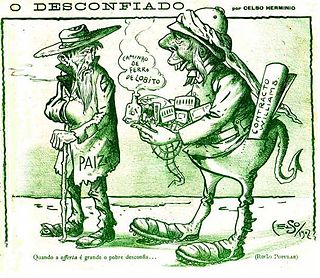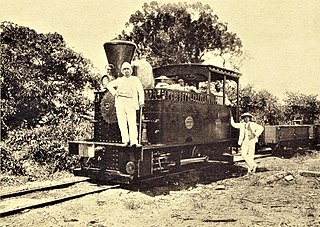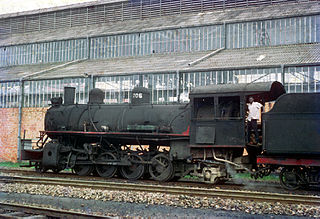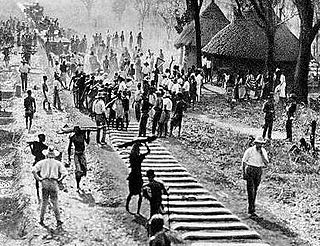| |||||
| Decades: | |||||
|---|---|---|---|---|---|
The following lists events that happened during 1900 in the Congo Free State .
| |||||
| Decades: | |||||
|---|---|---|---|---|---|
The following lists events that happened during 1900 in the Congo Free State .
| Date | Event |
|---|---|
| The Compagnie du Katanga and the Congo Free State create the Comité Spécial du Katanga (CSK) to manage all the territory in Katanga. [1] | |
| 24 August | Order of Leopold II is established by Leopold II as Sovereign of the Congo Free State. [2] |

Sir Robert Williams, 1st Baronet, was a Scottish mining engineer, pioneering explorer of Africa, entrepreneur, and railroad developer who was chiefly responsible for the discovery of the vast copper deposits in Katanga Province and Northern Rhodesia.

Rail transport is provided in the Democratic Republic of the Congo by the Société Nationale des Chemins de Fer du Congo (SNCC), the Société commerciale des transports et des ports (SCTP) (previously Office National des Transports until 2011), and the Office des Chemins de fer des Ueles (CFU).

The Société Nationale des Chemins de Fer Zaïrois (SNCZ) was the state railway company in Zaire formed in 1974 by combining several privately owned railways. It suffered from lack of maintenance of the tracks and rolling stock, weak management, and external factors such as the Angolan Civil War and the collapse of the economy of Zaire under President Mobutu Sese Seko. Despite two projects funded by the World Bank, it had virtually ceased to function by the 1990s. It was replaced in 1995 by the short-lived private company SIZARAIL, which in turn was replaced by the present Société nationale des chemins de fer du Congo.

The Mayumbe line was a 140 km (87 mi) long 610 mm gauge narrow gauge railway in the north west of the Democratic Republic of the Congo between the port of Boma and Tshela.

The South African Railways Katanga Mikado 2-8-2 of 1917 was a steam locomotive used in South Africa.

The Compagnie du chemin de fer du Congo supérieur aux Grands Lacs africains was a Belgian railway company established in 1902 in the Congo Free State, later the Belgian Congo, now the Democratic Republic of the Congo. It provided service in the eastern part of the colony south of Stanleyville (Kisangani) to serve the settlers and mining operations in Katanga. It operated a combination of river steamer service along the Lualaba River and railway links where the river was not navigable, including a link to Lake Tanganyika. In 1960 it became the Société congolaise des chemins de fer des Grands Lacs.

The Compagnie du Congo pour le Commerce et l’Industrie (CCCI) was a private enterprise in the Congo Free State, later the Belgian Congo and then the Democratic Republic of the Congo, whose subsidiaries engaged in a wide range of activities in the Congo between 1887 and 1971. These included railway and river transport, mining, agriculture, banking, trading and so on. It was the largest commercial enterprise in the Congo for many years. It went through various mergers in the years that followed before its successor Finoutremer was liquidated in 2000.

The Compagnie du chemin de fer du bas-Congo au Katanga (BCK) was a railway operator in the Congo Free State, Belgian Congo and later in the Democratic Republic of the Congo and Zaire. Most of the lines were in the southern Katanga Province, with links to the Kasai River for transport of mineral exports down to Kinshasa and onward to the port of Matadi, and a link to the Angolan railway network for transport to Lobito on the Atlantic.

The Compagnie de Chemin de fer du Katanga (CFK) was a railway company in the Congo Free State and Belgian Congo between 1902 and 1952. It held the railway concession that linked the port of Bukama on the navigable section of the Lualaba River through the mining region and the town of Elisabethville (Lubumbashi) to Sakania, where it connected with the Rhodesian railway network. Operations were subcontracted to the Compagnie du chemin de fer du bas-Congo au Katanga (BCK).
The Société des Chemins de fer Léopoldville-Katanga-Dilolo (LKD) was a railway concession owner in the Congo Free State, Belgian Congo. The network was built, maintained and operated by the Compagnie du chemin de fer du bas-Congo au Katanga (BCK).
The Société des Chemins de fer Katanga-Dilolo-Léopoldville (KDL) was a railway concession owner in the Congo Free State, Belgian Congo. The network was built, maintained and operated by the Compagnie du chemin de fer du bas-Congo au Katanga (BCK).

Jean Jadot (1862–1932) was a Belgian railway engineer who became a leading banker in the early 20th century.

The Special Committee of Katanga was a parastatal body created in 1900 by the Congo Free State and the Compagnie du Katanga. At first it was responsible for administering the huge Katanga Province on behalf of the Free State and for exploiting the province's mineral resources. Mineral exploration and mining were soon delegated to separate companies. After the Belgian Congo took over from the Free State in 1908, the CSK handed over its administrative powers to the provincial government. However, as a parastatal it remained responsible for many aspects of development in Katanga until independence in 1960, when it was dissolved.

Tanganyika Concessions Limited was a British mining and railway company founded by the Scottish engineer and entrepreneur Robert Williams in 1899. The purpose was to exploit minerals in Northern Rhodesia and in the Congo Free State. Partly-owned subsidiaries included the Union Minière du Haut-Katanga (UMHK), which undertook mining in the Katanga portion of the copperbelt, and the Benguela railway, which provided a rail link across Angola to the Atlantic Ocean. Belgian banks eventually took over control of the company. The Angolan railway concession was returned to the state of Angola in 2001.
The following lists events that happened during 1906 in the Congo Free State.
The following lists events that happened during 1936 in the Belgian Congo.
The following lists events that happened during 1902 in the Congo Free State.
The following lists events that happened during 1927 in the Belgian Congo.
The following lists events that happened during 1952 in the Belgian Congo.
Odon Jadot was a Belgian railway engineer and administrator. He was responsible for building more than 1,650 kilometres (1,030 mi) of railroad in the Belgian Congo. The lines helped carry copper mined in the Katanga Province to the sea via the ports of Matadi in the Congo, Dilolo in Angola and Beira in Mozambique. They also supported troop movements during World War I (1914–1918) and World War II (1939–1045).